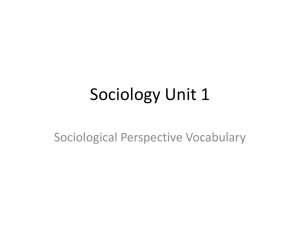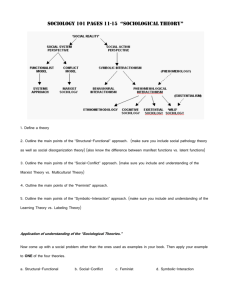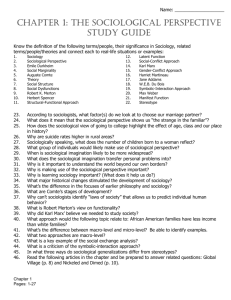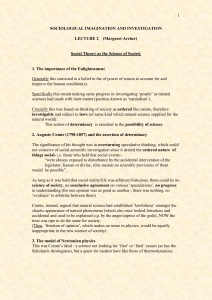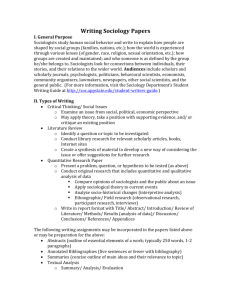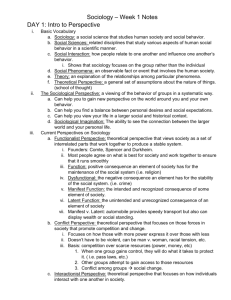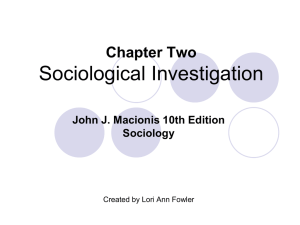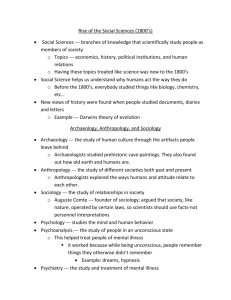Week 1: The Sociological Perspective
advertisement
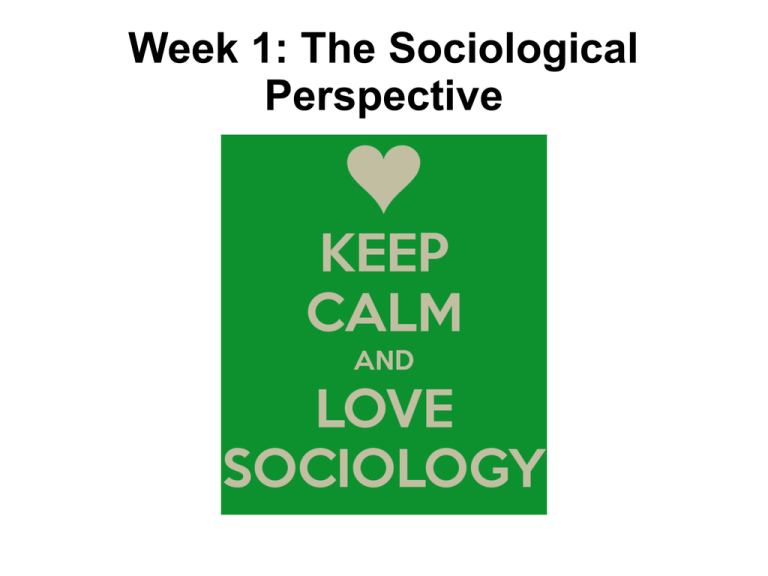
Week 1: The Sociological Perspective Sociology is the systematic study of human society Peter Berger described the sociological perspective as seeing the general in the particular The sociological perspective reveals the idea that society shapes what we think and do Two situations help us see clearly how society shapes individual lives: living on the margins of society and living through a social crisis The greater the people's marginality, the better they are able to use the sociological perspective People living at the margins of society (women, gay people, disabled, old) are aware of social patterns that others rarely think about To become better at using the sociological perspective, we must step back from our familiar routines and look at our lives with a new curiosity The sociological imagination helps people understand not only their society but also their own lives, because the two are closely related Just as social change encourages sociological thinking, sociological thinking can bring about social change The more we learn about how 'the system' operates, the more we may want to change it in some way What is the importance of a global perspective for sociology? a) where we live shapes the lives we lead b) societies throughout the world are increasingly interconnected c) thinking globally helps us learn more about ourselves In sum, in a increasingly interconnected world, we can understand ourselves only to the extent that we understand others Using sociology benefits us in four ways: a) it helps us assess the truth of 'common sense' b) it helps us see the opportunities and constraints in our lives c) it empowers us to be active participants in our society d) it helps us live in a diverse world Social Change and Sociology Three kinds of change were especially important in the development of sociology: the rise of a factory-based industrial economy, the explosive growth of cities, and new ideas about democracy and political rights It is Auguste Comte who coined the term sociology in 1838. Comte and other pioneers of sociology all cared about how society could be improved, but their major objective was to understand how society actually operates Comte saw sociology as the product of a three-stage historical development: the theological stage, the metaphysical stage and the scientific stage In the theological stage, people took a religious view that society expressed God's will In the metaphysical stage people saw society as a natural rather than a supernatural system In the scientific stage people used the scientific approach to study the physical world Comte's approach is called positivism, a way of understanding based on science A theory is a statement of how and why specific facts are related. Sociologists make use of three-major theoretical approaches: the structural-functional approach, the socialconflict approach, and the symbolic-interaction approach The Structural-Functional Approach A framework for building theory that sees society as a complex system whose parts work together to promote solidarity and stability All social structures function to keep society operating This approach owes much to Auguste Comte, who pointed out the need to keep society unified at a time when many traditions were breaking down Other pioneers Emile Durkheim, Herbert Spencer and Robert K. Merton Critical review: ignores inequalities of social class, race, and gender, which cause tension and conflict. Also, its focus on stability and unity at the expense of conflict makes it somewhat conservative The Social-Conflict Approach A framework for building theory that sees society as an arena of inequality that generates conflict and change Unlike the functional emphasis on solidarity and stability, this approach highlights inequality and change Many sociologists, including Karl Marx, use this approach not just to understand society but also to bring about societal change that would reduce inequality Marx: “The philosophers have only interpreted the world, in various ways; the point, however, is to change it.” The social-conflict approach is in two forms: a) feminism and the gender approach focuing on inequality and conflict between women and men b) and the race-conflict approach focusing on inequality and conflict between people of different racial and ethnic categories Critical review: largely ignores how shared values and interdependence unify members of a society The Symbolic-Interaction Approach Unlike the functional and the conflict paradigm that share a macro-level orientation (a broad focus on social structures that shape society as a whole), the symbolic-interaction approach has a micro-level orientation, that is a close-up focus on social interaction in specific situations It is a framework for building theory that sees society as the product of the everyday interactions of individuals Pioneers Max Weber and George Herbert Mead Critical Review: by focusing on what is unique in each social scene, this approach risks overlooking the widespread influence of culture, as well as factors such as class, gender, and race
